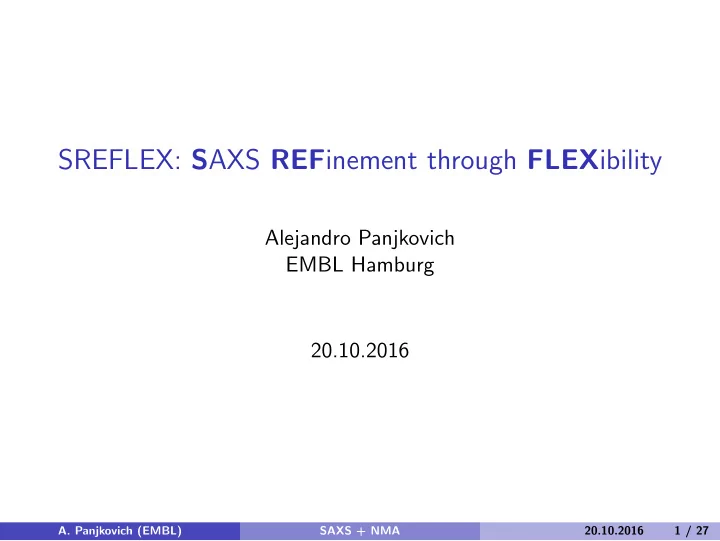

SREFLEX: S AXS REF inement through FLEX ibility Alejandro Panjkovich EMBL Hamburg 20.10.2016 A. Panjkovich (EMBL) SAXS + NMA 20.10.2016 1 / 27
Outline Motivation for flexible refinement SREFLEX method Example from user Running the program ◮ Standard run ◮ Advanced domain definition Interpreting results A. Panjkovich (EMBL) SAXS + NMA 20.10.2016 2 / 27
SAXS and conformational change Crystalline and solution conformation may differ SAXS can provide insight into conformational transition A. Panjkovich (EMBL) SAXS + NMA 20.10.2016 3 / 27
SAS modeling principle A. Panjkovich (EMBL) SAXS + NMA 20.10.2016 4 / 27
Estimating protein flexibility: normal mode analysis (NMA) Delarue M, Sanejouand YH (2002) Simplified normal mode analysis of conformational transitions in dna-dependent polymerases: the elastic network model. J Mol Biol 320: 1011-1024. A. Panjkovich (EMBL) SAXS + NMA 20.10.2016 5 / 27
Time for some movement A. Panjkovich (EMBL) SAXS + NMA 20.10.2016 6 / 27
SREFLEX: S AXS REF inement through FLEX ibility A. Panjkovich (EMBL) SAXS + NMA 20.10.2016 7 / 27
SREFLEX: S AXS REF inement through FLEX ibility Input: SAXS data PDB coordinates Program stages: 1 Structure partition 2 Domain level refinement 3 Residue level refinement A. Panjkovich (EMBL) SAXS + NMA 20.10.2016 8 / 27
Automatic domain assignment based on dynamics A. Panjkovich (EMBL) SAXS + NMA 20.10.2016 9 / 27
Assignment comparison, SCOP vs. auto A. Panjkovich (EMBL) SAXS + NMA 20.10.2016 10 / 27
Experimental example: Josephin domain of ataxin-3 Nicastro et al. (2006) J. Biomol. NMR 36 , 267-77 A. Panjkovich (EMBL) SAXS + NMA 20.10.2016 11 / 27
Experimental example: MurA Sch¨ onbrunn et al. (1998) Eur. J. Biochem. 253 , 406-412 A. Panjkovich (EMBL) SAXS + NMA 20.10.2016 12 / 27
SREFLEX: examples from benchmark A. Panjkovich (EMBL) SAXS + NMA 20.10.2016 13 / 27
SREFLEX benchmark χ 2 < 2.0 ∆ RMSD target > 1.0 Å 100 100 closing closing opening opening 80 total 80 total % benchmark cases % benchmark cases 60 60 40 40 20 20 0 0 scop auto ffs scop auto fs RMSD target < 5.0 Å 70 closing opening 60 total % benchmark cases 50 40 30 20 10 0 scop auto ffs A. Panjkovich (EMBL) SAXS + NMA 20.10.2016 14 / 27
Panjkovich A & Svergun DI (2016) Phys. Chem. Chem. Phys. 18 , 5707-19 A. Panjkovich (EMBL) SAXS + NMA 20.10.2016 15 / 27
SREFLEX, user example A. Panjkovich (EMBL) SAXS + NMA 20.10.2016 16 / 27
SREFLEX, ab-initio model mismatch A. Panjkovich (EMBL) SAXS + NMA 20.10.2016 17 / 27
SREFLEX, conformational change A. Panjkovich (EMBL) SAXS + NMA 20.10.2016 18 / 27
Conformational change fits ligand binding A. Panjkovich (EMBL) SAXS + NMA 20.10.2016 19 / 27
SREFLEX, web interface (ATSAS online) A. Panjkovich (EMBL) SAXS + NMA 20.10.2016 20 / 27
SREFLEX, command line interface A. Panjkovich (EMBL) SAXS + NMA 20.10.2016 21 / 27
Divide et impera - split your structure into pieces The new ATSAS binary partistr may help Check Pfam or SCOP domains Use your intuition (particularly for opening structures) Feed the structure as ◮ d1.pdb,d2.pdb,d3.pdb (command line) ◮ Or as a .zip file to the ATSAS-online version A. Panjkovich (EMBL) SAXS + NMA 20.10.2016 22 / 27
Interpretation of SREFLEX results Restrained models (rc), higher χ 2 but better stereochemistry Unrestrained models (uc), lower χ 2 , more structural distortion Prioritize lower RMSD against initial structure Check degree and relevance of clashes and breaks Make an informed decision on which model is the better choice A. Panjkovich (EMBL) SAXS + NMA 20.10.2016 23 / 27
Use the proper tool for your question MW or oligomeric state are way off (better SASREF) There are long linkers or unstructured regions (better use EOM) Unrealistic expectations (folding problem not yet solved) A. Panjkovich (EMBL) SAXS + NMA 20.10.2016 24 / 27
Summary Motivation Understanding the approach Running the program ◮ Standard run ◮ Custom domain definition Interpreting results A. Panjkovich (EMBL) SAXS + NMA 20.10.2016 25 / 27
Acknowledgements Dmitri Svergun and the rest of the SAXS team at EMBL Hamburg (http s :// www. embl-hamburg.de/biosaxs/) Funding: ◮ EMBL and Marie Curie Actions for postdoc fellowship (EIPOD) A. Panjkovich (EMBL) SAXS + NMA 20.10.2016 26 / 27
SAS in structural biology ab-initio shape determination missing fragments rigid-body hybrid modeling mixtures ensemble approach A. Panjkovich (EMBL) SAXS + NMA 20.10.2016 27 / 27
Recommend
More recommend